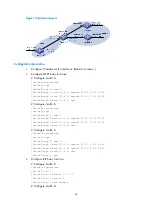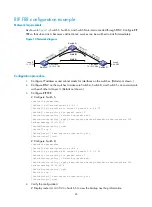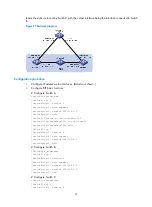
35
Figure 9
Network diagram for RIP FRR
, after you enable FRR on Router B, RIP designates a backup next hop using a routing policy
when a network failure is detected. Packets are directed to the backup next hop to reduce traffic recovery
time. At the same time, RIP calculates the shortest path based on the new network topology, and forwards
packets over the path after network convergence.
Configuration prerequisites
You need to specify a next hop by using the
apply fast-reroute backup-interface
command in a routing
policy and reference the routing policy with RIP FRR. For more information about routing policy
configuration, see "
Configuration guidelines
•
RIP FRR is only effective for non-recursive RIP routes (that are learned from directly connected
neighbors).
•
Do not use RIP FRR and BFD (for RIP) at the same time; otherwise, RIP FRR may fail to take effect.
•
RIP FRR is available only when the state of primary link (with Layer 3 interfaces staying up) changes
from bidirectional to unidirectional or down. A unidirectional link refers to the link through which
packets are forwarded only from one end to the other.
Configuration procedure
To configure RIP FRR:
Step Command
Remarks
1.
Enter system view.
system-view
N/A
2.
Configure the source address
of echo packets.
bfd echo-source-ip
ip-address
Not configured by default.
3.
Enter RIP view.
rip
[
process-id
] [
vpn-instance
vpn-instance-name
]
N/A
4.
Enable RIP FRR and reference
a routing policy to designate
a backup next hop.
fast-reroute route-policy
route-policy-name
Disabled by default.
Configuring BFD for RIP
BFD for RIP provides the following link detection modes:
•
Single-hop detection in BFD echo packet mode for a directly connected neighbor. In this mode, a
BFD session is established only when the neighbor has route information to send.






























